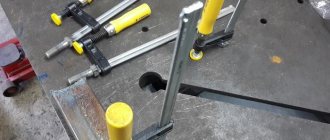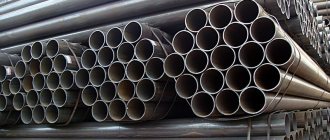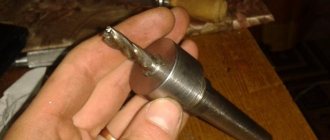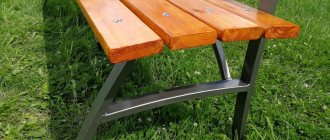SHARE ON SOCIAL NETWORKS
FacebookTwitterOkGoogle+PinterestVk
Do-it-yourself cold forging is a method of forming metal products under pressure. This method consists in the fact that the metal is not heated before deformation, but is bent using special machines. Forged patterns will decorate garden fences, stair railings, windows or entrance doors. Simplicity and low cost will allow anyone to quickly master the process and independently bring their ideas to life.
Using the cold forging method you can create incredibly beautiful products
Why is cold forging used and what products are produced?
This method allows you to produce various metal elements for decorative purposes without preheating. These are curls, spirals, peaks, rings, twisted rods, etc. Using electric welding, they are combined into products that combine practical function and artistic value:
- Grilles, fences. Reproducing the Gothic style, the upper part of the fence is decorated with peaks. This makes the fence difficult to overcome.
- Lanterns.
- Railings for the porch and bridge over the pond.
- Canopies, canopies.
- Garden furniture: benches, tables. Items with curled backs and armrests serve as decoration for the area.
- Balcony railings.
- Gazebos.
- Barbecues.
- Interior elements in the house: fireplace grates, hangers, cornices, etc.
Abstract patterns or images of leaves, bunches of grapes, etc. are assembled from the constituent elements.
Forged gazebo with barbecue.
Application options
The most popular metal product: forged gates and fences. Massive or patterned, made of pure metal or alloy - they look equally sophisticated and elegant. But forged products are not just interior decoration. Metal shutters, stair railings, decorative gates and balconies are able to withstand high loads, sudden temperature changes and exposure to the elements.
Non-functional forms of interior elements include rotundas, fences for flower beds, figurines of plants and animals. They will decorate any garden and emphasize its individuality.
The ability to give a product any shape allows you to create designs of any complexity - thanks to this, artistic forging remains the most popular way of decorating a home.
A gate made in the shape of a dragon will attract the attention of guests and arouse the envy of neighbors
Types of Cold Forging
To give the workpieces the desired shape, special machines, presses and stamps are used. The technology includes the following operations:
- bending;
- calibration;
- firmware;
- tenderloin;
- stamping;
- winding
The equipment allows for mass production of identical products.
The following types of rolled metal are used as blanks:
- round and square rod with a thickness of 8-16 mm;
- strip;
- sheet metal.
Relief decorations are made from steel plates using the hammer embossing method.
The material used in cold forming is low-carbon steel, which is soft and ductile. The most common brand is St3.
Cold forging techniques and technology
Changing the shape of blanks is carried out using the following methods:
- flexible;
- torsion;
- broaching;
- minting.
A distinctive feature of cold deformation of metal is the simplicity of the technological process. So, bending is carried out in the following sequence:
- Install the mandrel of the required size.
- Rigidly fix one end of the workpiece.
- Bend it, covering the mandrel. As a result, a monogram or curl of the desired size, shape and direction is obtained.
A rod of square cross-section is subjected to torsion. To perform the operation, you only need a vice and a collar with a long lever. If performed manually, the operation will require a lot of effort. The result is a rod that is evenly twisted around its own axis. You can place 2 products in a vice and wrap them around one another. This is done, for example, by the outer supports of balcony railings.
Interesting: Types and equipment of metal slitting
The broaching operation consists of moving the workpiece between the rollers, as a result of which it is compressed. In most cases, using this method, the ends of the rods are given a pointed shape.
Custom embossing is done by hand using a hammer. In mass production, a stamp is used. The mechanism extrudes the design with a moving part - a punch.
Torsion is one of the forging methods.
Interesting Facts
The peak of development of artistic forging as a separate art occurred in the 6th-8th centuries AD. To become a master, future blacksmiths began training in early childhood. At first, the apprentice only observed and helped the blacksmith: he handed over tools, looked after the stove, brought water and firewood. Gradually, the student was allowed to do simple work: preparing metal and forging small, simple elements. After 5-6 years of training, the young blacksmith was already able to independently produce various types of products: from door handles to forged swing gates.
The entire forging process was done by hand. An experienced craftsman could determine the type of metal by examining the breakdown of the product and the type of spark produced. The temperature was also determined by its appearance: focusing on the color of the red-hot part, the master accurately determined at what moment it warmed up to the required temperature.
Forged products made to order were especially popular. During the period from the 13th to the 15th century AD. e. Rich nobles loved to decorate their estates with forged fences, gates, window bars and various interior items. Many products have survived to this day and are a cultural achievement of the nation.
Hephaestus - ancient Greek god of fire and blacksmithing
Differences between cold forging and other metalworking methods
In addition to this method, the following is used for the production of metal products:
- Casting. The alloy is heated to a liquid state and poured into molds.
- Mechanical processing (using a cutting tool). The workpiece is turned, drilled, planed, etc.
- Hot forging and stamping. The workpiece is subjected to impact in a heated state.
Thus, the differences between cold processing and alternative methods are as follows:
- The workpiece is not preheated.
- Its integrity and structure are not violated. The required shape is achieved by cold working under the influence of external force.
Metals used
For artistic forging, pure metals and various types of alloys are used. These include:
- Bronze. This is an artificially created material made from an alloy of copper and tin. Bronze is hard, but malleable when processed; its structure allows it to imitate other metals.
- Brass. Yellow metal, looks like gold. It is made by combining copper and zinc. Brass can be varnished, painted, or given any texture.
- Copper. Basically, roofs and hoods are made from this material. Copper has a beautiful red-brown color and can be given different shades by polishing. Decorative copper items such as cups, frames and ornaments are also popular.
- Cast iron. It is made from an alloy of iron and carbon. Massive products are made from it: fences, spiral staircases. Cast iron is a malleable material, it can be covered with a patina and get any desired color: from black to golden.
- Steel. This is a universal material from which you can make any product, including a sewing needle. To produce steel, iron is combined with carbon - the resulting alloy is soft and ductile when heated, and becomes strong when solidified.
- Blued steel. To obtain this material, steel is dipped in oil and fired. During the cooling process, a protective film is formed that protects the metal from corrosion. From blued steel you can make thin lace products: carved shutters and fences.
- Stainless steel. It is created by combining iron with chromium, nickel and titanium. Stainless steel is a durable material that is difficult to texture. Most often it is sanded and lightly polished to achieve a matte finish.
- Zinc. When polished it gives a wide variety of shades. Suitable for massive outdoor products.
- Titanium. It has a noble dark shade and good reflectivity. Titanium furniture is ideal for modern high-tech style.
- Zinkotitan. A material that requires patience: it is difficult to machine, but chemical etching can produce beautiful textures.
- Gold. A very soft and pliable material, famous for its high cost. Miniature products are made from gold, most often jewelry. Gold plating is also popular: a product made of cheaper metal is covered with a thin gold film on top.
- Silver. Metal with the highest reflective properties. In ancient times, mirrors were made from silver; for modern decor, silver frames, trays, cups, and furniture trim are often ordered.
Regardless of the type of metal chosen, a product created by artistic forging will look beautiful and expensive. Metal interior details emphasize the status of the owner of the home and create a unique atmosphere.
Table made of bronze. Every detail is forged with love
Advantages and disadvantages
Advantages
Low cost. It is explained by low energy and labor costs.
There are no requirements regarding the qualifications of the performer. If hot forging is accessible only to a professional blacksmith with developed skills and a powerful furnace, then anyone can do cold forging, and at home.
High aesthetic merits. Gates, grilles and other products look expensive, noble and attractive; From a distance they look like forged ones.
High production speed. A set of elements for gates can be completed in half a day. It will take a week to make them by hand hot forging.
The ability to create original products by combining standard elements in different ways.
Flaws
Limited set of starting materials and final forms. For this reason, objects made by this method cannot be compared in artistic value with those obtained by traditional hot forging.
The need for special equipment.
Special equipment is one of the disadvantages of cold forging.
Tools and materials for cold forging
The master must have the following:
- Special machines.
- Welding machine. Used to assemble decorative elements into a single composition.
- A grinder with a metal disc. It is used to cut rolled products into blanks.
- Clamps or other devices for permanently fixing elements before welding.
- A brush with metal bristles.
- With a hammer.
- Brush for applying enamel. Low carbon steel needs protection against corrosion.
- With a tape measure.
Materials used:
- Rolled steel: rod, strip, sheet.
- Coated consumable electrodes. The design is not critical, so rutile consumables like MP-3 are suitable.
- Enamel for exterior use.
Metal processing stages
- Heat treatment of materials. This is a preliminary stage of work, during which the metal is heated to the desired temperature. Heating occurs in a forge or induction furnace. Heating time depends on the type of metal. The heat treatment process also includes cooling, tempering and hardening of the metal.
- Forging. The process of manufacturing parts. During forging, the master gives the material the desired shape using various techniques. The process of heat treatment and forging can be repeated many times, since the workpiece quickly cools and loses the temperature necessary for operation.
- Assembly. During the assembly process, parts are connected to each other into a single product. The simplest type of assembly is welding. At the welding site, the parts are heated and connected to each other: the heated metal instantly adheres and hardens. Assembly using rivets and clamps is also possible.
- Decoration. In simple forging, the blacksmith completes the work by polishing the product, giving its surface reflective properties and the desired texture. In artistic forging, additional techniques can be used: etching and embossing. Etching is the application of chemicals to the surface of a product that react with the metal and give it its original color. Embossing - applying an ornament using.
Cold forging equipment
Elements are manufactured on several machines. The name of each device corresponds to the operation performed with it.
Snail
This equipment is designed for curling the workpiece into a flat spiral. In its simplest form, it is a massive table with a template made of a thick steel strip attached to it.
Having fixed the end of the workpiece in the center, it is deformed with a bending lever.
In a more complicated version, the template is made of several hinged links and installed on a rotating table. The workpiece is pressed by a roller. As the shaft rotates, the template gradually unbends.
Gnutik
This machine bends the rolled product at the desired angle. It consists of the following components:
- Beds.
- Fixed stops with pressure rollers for fixing the workpiece.
- Guides.
- A movable stop moving along them.
- Screw mechanism.
Interesting: What is electroplating of metal
An overlay with a profile corresponding to the required bending shape is attached to the movable stop. The necessary force is created by a screw mechanism.
By rotating the table with the workpiece attached to it, you can obtain any flat and spatial shapes.
Wave
The final product is a rounded zigzag. The main elements of the machine are the central and bypass rollers, the latter is mounted on the carrier. You can also retrofit the “snail” or use a “grip”, equipping the movable stop with an overlay of the appropriate profile.
Flashlight
The machine twists several rods at once, installed in a circle. The result is a spatial structure of a cylindrical shape with spiral walls. A stop with a lock and a movable gate are fixed to the frame.
globe
Using this machine, arched ceilings and other products in the form of an arc with a large radius are made. The workpiece is crimped according to a template using a bending lever with a movable roller.
This machine is used for mass production. In single quantities, arcs can be produced on a “bending machine”.
Blacksmithing machine Globe.
Twister
The device twists the workpiece around the longitudinal axis. To do this, one end is rigidly fixed, and the other is rotated with a movable collar. This unit can move along the workpiece, which allows you to adjust the pitch of the spiral.
Homemade equipment for cold forging
You can make machines yourself. A novice craftsman should first of all acquire a “snail”, since spirals and curls are the most popular decorative element. By changing the bending radius and the number of windings, you can create many beautiful original products using only this machine.
What you need
Cold deformation of steel blanks requires great effort. Therefore, all machine components must be durable and massive. The following materials are used for their manufacture:
- Table top – sheet with a thickness of 10 mm.
- Bending lever – profiled pipe with a cross section of 40x25x3 (mm). It is allowed to use a product with a wall of 2 mm.
Some parts cannot be made at home. Examples:
- Bed and movable stop "bend". The material is high-strength steel, so manufacturing requires milling and drilling machines.
- Central and bypass “wave” rollers. They experience heavy loads, so they are made of tool steel. Its processing also requires industrial equipment.
Such parts should be ordered from a production site with a good fleet of metalworking machines.
Manufacturing of the machine
The snail device is made in the following sequence:
- A round tabletop is cut from sheet steel.
- A thick-walled pipe leg with brackets for fastening to the floor is welded in the center. To give stability, it can be strengthened with struts.
- Install the bending lever. One end of it is attached to the leg so that rotation remains possible. On the other hand, the lever is equipped with pressure rollers on bearings.
- A template made of a thick strip is attached to the tabletop. It should repeat the shape of the future part with a small tolerance (determined experimentally). Pins are welded to the template, and holes are drilled in the tabletop for them. This method of fixation will make it possible to produce elements with different radii of curvature.
Interesting: Types of metal cutting equipment
Attaching the bending arm to the machine leg can be done in 2 ways:
- Using a bearing. This is the best option, it provides easy rotation.
- By means of a sleeve made of a larger diameter pipe. A support ring is welded on the bottom. In this case, rotating the lever will require a lot of effort, but if there is lubrication, the operation will be accessible even to a person of average build.
Torsion bar machine
As already mentioned, these cold forging machines allow you to make longitudinal bends on the rod. This is a relatively simple design. The main task is to fix one end of the rod motionless, attach a lever to the second, with which you can twist the workpiece.
A piece of profiled pipe with a thick wall (at least 3 mm) is suitable as a base. The retainer can be welded from the same rods, leaving a square gap of the required diameter. You can use a properly sized cable clamp (available at a rigging store). Any of these stops is welded to the base.
Cable holder - great for holding rods
Next, you need to somehow ensure grip and torsion of the second part of the workpiece. This can be done using two bearing units. A pipe of a suitable diameter is inserted inside, and a handle is welded to it on one side - the design resembles the letter “T”. On the other hand, a clamp is made in the pipe: four holes are drilled, nuts for 12 or 14 bolts are welded into them. The result is a good clamp - the bolts are tightened after the rod has been inserted.
Bearing unit
Workpiece clamp
This is what the design looks like as a whole
Next - a matter of technique - use a lever to screw in the required number of turns. This is not to say that this work is for weaklings, but with a lot of leverage, everything is not so difficult.
Watch the video for an even simpler machine for making torsion bars using cold forging:
Creating patterns for products with your own hands
To select the optimal arrangement of decorative elements, it is recommended to view photos on the Internet. Taking the pattern you like as a basis, it is complemented and modified in accordance with your own ideas.
It is recommended to draw the future product on a flat surface with chalk on a scale of 1:1. It may turn out that the pattern looks attractive on paper or a computer screen, but not in real size. To facilitate the process of transferring to a plane, you can make paper models of curls and other elements.
Styles and elements
Patterns are divided into types:
- geometric;
- vegetable;
- animals.
In the first group there are several styles:
- Romanesque. It is characterized by strict lines and a large number of similar elements. When arranging the ornament, symmetry is observed.
- Gothic. Contains a large number of elements directed upward: pointed arches, peaks, sharp spikes, etc. Spirals and curls are made forked, reminiscent of a plant stem. The straight lines of the rods are complemented by lanterns.
- Baroque. Characterized by lush openwork ornaments. Geometric patterns are complemented by plant elements - leaves and flowers.
- Renaissance. This style is dominated by rounded, smooth lines. Relatively rare.
- Empire style This style, on the contrary, assumes the presence of a large number of long smooth rods. Even the curls are made elongated with spirals at the ends.
The following parts are most often produced using cold forming methods:
- Curls. They are used most often. They have different shapes, for example, they are S- and C-shaped. The second option is called volute.
- Spirals. There are flat and spatial, single and double.
- Spin it. A rod or strip twisted around its own longitudinal axis.
- Peaks. A pointed element at the end of a rod.
- Minting. An imitation of a leaf, petal, flower or animal made from thin metal.
- Rings.
Formation of the ornament
The elements are placed on a flat surface into a pattern and connected in one of the following ways:
- Welding.
- Artistic clamps (rivets).
The second option is used in places where the weld cannot be made invisible. The rivets are shaped so that they harmoniously complement the pattern.
After removing slag, weld seams are leveled with a grinder equipped with a grinding disc. The entire ornament is treated with it before painting.
Photo galleries
Gates and wickets
A family monogram on the gate will turn an ordinary house into a family nest
Gates made according to the client's sketch. Simple but tasteful
Beautiful gates can be made for a garage
Beauty is in every detail - that’s why artistic forging is so popular
Simple elements create a beautiful composition
Firebird on the gate - Russian fairy tales in the modern world
Fences and railings
Beauty is in simplicity. Behind such a fence can hide both a village hut and a three-story cottage
The stone pedestal and the fence, as if “grown” into it, create a single composition
Iron roses are in no way inferior in beauty to the tulips growing nearby. A professional blacksmith can breathe life into soulless metal!
It seems like an unremarkable fence. But even she is beautiful in some way
Interweaving of leaves and flower buds. The master did a great job
Thin branches, as if alive, entwine the fence. The composition seems fragile, but will last for centuries
Stairs and railings
Amazing beauty! Correctly selected colors create the impression of a play of light and shadow
Few people will notice a flower with four petals here, but everyone will appreciate the beauty of the pattern.
The staircase and chandelier were created by the same blacksmith and therefore fit perfectly together
Patterns, lines, flowers. Simple, elegant and beautiful
A very unusual pattern. Fancy forged railing elements
A wrought iron staircase complements the interior. And it seems that she and the chair are one whole. Here the work of the designer is no less important than the quality of forging











